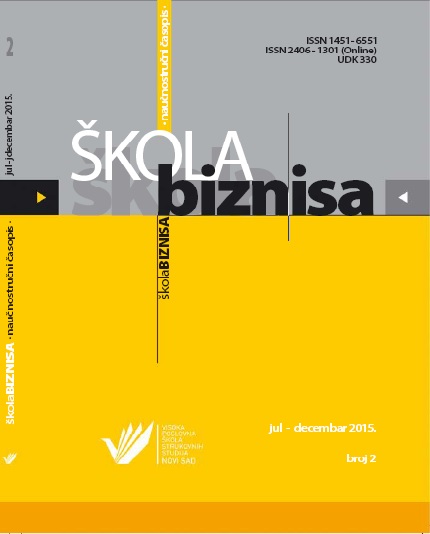TEHNOLOŠKI LIDERI UPOTREBE RAČUNARA I VEBA 2.0 U VISOKOM OBRAZOVANJU: STUDIJA SLUČAJA
Sažetak
Razvoj upotrebe IKT i otvorenih koncepata je donelo visokom obrazovanju novu učeničku paradigmu kreiranja znanja. Glavna uloga u ovom novom konceptu sa aspekta infrastrukture je dodeljena Vebu 2.0. Autori ovog rada predstavljaju studiju slučaja sa iskustvima studenata institucije visokog obrazovanja. U prvom delu rada autori analiziraju od studenata prikupuljene podatke koji se odnose na pristup Internetu i njihovim aktivnostima na Internetu. Ovo istraživanje je sprovedeno korišćenjem upitnika zasnovanim na indikatorima definisanim od strane Eurostata kao i podacima koje su autori našli u studentskim projektima kreiranim korišćenjem alata Veba 2.0. Glavni cilj ovog rada je da se analizira kako studenti u Srbiji koriste alate Veba 2.0 u njihovom istraživačkom radu. Autori su uočili određene trendove u korišćenju alata Veba 2.0 i najpopularnijih tehnologija, zaključujući da alati Veba 2.0 ubrzavaju proces razvoja projekata.
Reference
Ahrens, A., Wen, M. L. Y., Huang, Y. H., Zascerinska, J., & Bassus, O. (2010). A Comparative Study of the Relationship between Social Dimension of Web 2.0 Technologies and E-Learning: Students' View in Germany and Taiwan. Innovation and Entrepreneurship and its Implications in Engineering and Business Education. Philippines: Manila.
Amersdorffer, D., Bauhuber, F., & Oellrich, J. (2012). The economic and cultural aspects of the social web: Implications for the tourism industry. Journal of Vacation Marketing. 18(3), 175-184.
Anderson, P. (2010). What is Web 2.0? Ideas, technologies and implications for education. Retrieved from http://www.scribd.com/doc/300024/What-is-web-20-Ideas-technologies-and-implications-Paul-Anderson.
Brusilovsky, P., & Peylo, C. (2003). Adaptive and Intelligent Web-based Educational Systems, International Journal of Artificial Intelligence in Education, 13(2-4), 159-172.
Casey, G., & Evans, T. (2011). Designing for Learning: Online Social Networks as a Classroom Environment. The International Review of Research in Open and Distance Learning, 12(7), 1-26.
Chi, H. (2012). Who Knows? Searching for Expertise on the Social Web. Communications of the ACM, 55(4), 110-110.
Chou, H. W., Chang, K. C., & Lin, Y. H. (2013). Investigating Facebook and Google usage in Taiwan's college students. International Journal of Services Technology & Management, 19(4-6), 201-218.
Devedžić, V. (2004). Education and the Semantic Web. International Journal of Artificial Intelligence in Education, 14(2), 165-191.
Fieseler, C., & Fleck, M. (2013). The Pursuit of Empowerment through Social Media: Structural Social Capital Dynamics in CSR-Blogging. Journal of Business Ethics, 118(4), 759-775.
European Commission. Eurostat – Information Society Data Collection. Retrieved from http://epp.eurostat.ec.europa.eu/portal/page/portal/information_society/introduction/
Greenhow, C. (2007). What Teacher Education Needs to Know about Web 2.0: Preparing New Teachers in the 21st Century. In: R. Carlsen et al. (eds.), Proceedings of Society for Information Technology & Teacher Education International Conference 2007 (pp. 1989-1992).
Hew, K. F., & Cheung, W. S. (2013). Use of Web 2.0 Technologies in K-12 and Higher Education: The Search for Evidence-Based Practice. Educational Research Review, 9, 47-64.
Jošanov, B., Marošan, Z., & Tomić, R. (2010). ICT as a Facilitator for e-Learning 2.0 Implementation. In: Proceedings from IASK Teaching and Learning 2010 International Conference (pp. 734-738), Seville.
McLean, R., Richards, B. H., & Wardman I. (2007). The effect of Web 2.0 on the future of medical practice and education: Darwikinian evolution or folksonomic revolution? Medical Journal of Australia, 187(3), 174-177.
O’Reilly, T. (2007). What is Social web: Design Patterns and Business Models for the Next Generation of Software. International Journal of Digital Economic, 65, 17-37.
Paavola, S., Lipponen, L., & Hakkarainen, H. (2004). Models of Innovative Knowledge Communities and Three Metaphors of Learning. Review of Educational Research, 74(4), 557-576.
Peštek, A., Kadić-Maglajlić, S., & Nožica, M. (2012). Implications of Web 2.0 Usage in Higher Education. International Journal of Management Cases, 14(1), 3-12.
Pritchett, C. C., Wohleb, E. C., & Pritchett, C. G. (2013). Educators' Perceived Importance of Web 2.0 Technology Applications. TechTrends: Linking Research and Practice to Improve Learning, 57(2), 33-38.
Sangeeta Namdev, D. (2012). ICT and Web Technology Based Innovations in Education Sector. Turkish Online Journal of Distance Education, 13(4), 256-268.
Sezen Balcikanli, G. (2012). Social Networking in Physical Education: Undergraduate Students' Views on Ning. Turkish Online Journal of Distance Education, 13(2), 277-290.
Sfard, A. (1998). On Two Metaphors for Learning and the Dangers of Choosing Just One. Educational Researcher, 27(2), 4-13.
Surčulija, J., Pavlović, B., & Jovanović Padejski, Đ. (2011). Mapping Digital Media: Serbia: A Report of Open Society Foundation. Belgrade: Open Society Media Program.
Thackeray, R., Neiger, B. L., Hanson, C. L., & McKenzie, J. F. (2008). Enhancing Promotional Strategies Within Social Marketing Programs: Use of Web 2.0 Social Media. Health Promotion Practice, 9(4), 338-343.
Turban, E., & Volonino, L. (2010). Information Technology for Management. Denver, MA: John Wiley & Sons.
Von Hippel, E. (2005). Democratizing Innovation. Cambridge. Massachusetts: MIT Press.
Wankel, L.A., & Wankel, C. (2011). Higher Education Administration with Social Media. Bingley, UK: Emerald Group Publishing Limited.
Wellman, B., Salaff, J., Dimitrova, D., Garton, L., Gulia, M., & Haythornthwaite, C. (1996). Computer-Supported Social Networks. Annual Review of Sociology, 22, 213-238.
Wiley, D. (2010). Openness as Catalyst for an Educational Reformation. EDUCAUSE Review, 45(4), 14–2.
- Autori zadržavaju autorska prava i pružaju časopisu pravo prvog objavljivanja rada i licenciraju ga "Creative Commons Attribution licencom" koja omogućava drugima da dele rad, uz uslov navođenja autorstva i izvornog objavljivanja u ovom časopisu.
- Autori mogu izraditi zasebne, ugovorne aranžmane za neekskluzivnu distribuciju članka objavljenog u časopisu (npr. postavljanje u institucionalni repozitorijum ili objavljivanje u knjizi), uz navođenje da je članak izvorno objavljen u ovom časopisu.
- Autorima je dozvoljeno i podstiču se da postave objavljeni članak onlajn (npr. u institucionalni repozitorijum ili na svoju internet stranicu) pre ili tokom postupka prijave rukopisa, s obzirom da takav postupak može voditi produktivnoj razmeni ideja i ranijoj i većoj citiranosti objavljenog članka (Vidi Efekti otvorenog pristupa).

